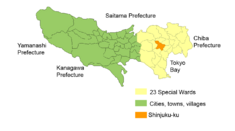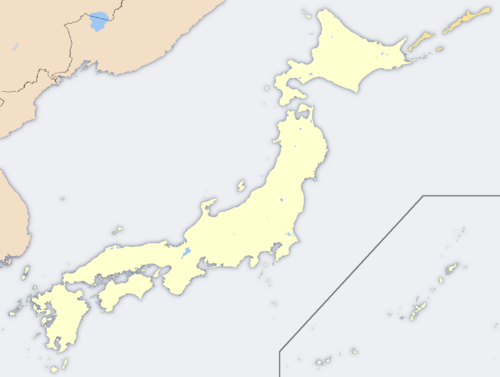Shinjuku, Tokyo
 Shinjuku's location in Tokyo, Japan. |
|
 Shinjuku's location in Japan. |
|
| Location | |
| Country | Japan |
| Region | Kantō |
| Prefecture | Tokyo |
| Physical characteristics | |
| Area | 18.23 km2 (7.04 sq mi) |
| Population (as of 2008) | |
| Total | 312,418 |
| Density | 17,140 /km² (44,392 /sq mi) |
| Location | |
| Symbols | |
| Tree | Zelkova serrata |
| Flower | Azalea |
 Flag |
|
| Shinjuku Government Office | |
| Mayor | Hiroko Nakayama |
| Phone number | 03-3209-1111 |
| Official website: Shinjuku | |
Shinjuku (新宿区 Shinjuku-ku?) is one of the 23 Special wards of Tokyo, Japan. It is a major commercial and administrative center, housing the busiest train station in the world (Shinjuku Station), and the Tokyo Metropolitan Government Building, the administration center for the government of Tokyo.
Surrounding Shinjuku Station are department stores, specialist electronic and camera shops, cinemas, restaurants and bars. Many international hotels are located here.
As of 2008, the ward has an estimated population of 312,418 and a density of 17,140 persons per km². The total area is 18.23 km².[1]
Shinjuku has the highest numbers of registered foreign nationals of any community in Tokyo. As of October 1, 2005, 29,353 non-Japanese with 107 different nationalities were registered in Shinjuku.
Contents |
Geography




Surrounding Shinjuku are six other wards: Chiyoda to the east; Bunkyo and Toshima to the north; Nakano to the west, and Shibuya and Minato to the south. In addition, Nerima is only a hundred meters away. The highest point in Shinjuku is Hakone Hill, 44.6 m, in Toyama Park east of Takadanobaba and Shin-Okubo stations. The lowest point is 4.2 m in the Iidabashi area.
Places in Shinjuku include
- Ichigaya: A commercial area in eastern Shinjuku, site of the Ministry of Defense.
- Golden Gai: An area of tiny shanty-style bars and clubs. Musicians, artists, actors and directors gather here, and the ramshackle walls of the bars are literally plastered with movie posters.
- Kabukichō: A district well-known for bars, restaurants and red-light district with street prostitutes, brothels, and other sexual commerce. Located northeast of Shinjuku Station.
- Nishi-shinjuku: Tokyo's largest skyscraper district. Several of the tallest buildings in Tokyo are located in this area, including the Tokyo Metropolitan Government Building, KDDI Building and Park Tower. Located west of Shinjuku Station.
- Ōkubo: Tokyo's best-known Korean district.
- Shinanomachi: On the southern edge of Shinjuku, close to the National (Olympic) Stadium, and Meiji-Jingu Stadium (where the Yakult Swallows baseball team plays).
- Shinjuku Gyoen is a large park, 58.3 hectares, 3.5 km in circumference, blending Japanese traditional, English Landscape and French Formal style gardens.
- Shinjuku ni-chōme: Tokyo's best-known gay district.
- Waseda: Surrounding Waseda University, one of the most prestigious private universities in Japan. Nearby Takadanobaba is a major student residential and nightlife area.
History
In 1634, during the Edo period, as the outer moat of the Edo Castle was built, a number of temples and shrines moved to the Yotsuya area on the western edge of Shinjuku. In 1698, Naitō Shinjuku had developed as a new (shin) station (shuku or juku) on the Kōshū Kaidō, one of the major highways of that era. Naitō was a daimyo whose mansion stood in the area; his land is now a public park, the Shinjuku Gyoen.
Shinjuku began to develop into its current form after the Great Kantō earthquake in 1923, since the seismically stable area largely escaped the devastation. Consequently, West Shinjuku is one of the few areas in Tokyo with many skyscrapers.
The Tokyo air raids from May to August 1945 destroyed almost 90% of the buildings in the area in and around Shinjuku Station. [1] The pre-war form of Shinjuku, and the rest of Tokyo, for that matter, was retained after the war because the roads and rails, damaged as they were, remained, and these formed the heart of the Shinjuku in the post-war construction. Only in Kabuki-cho was a grand reconstruction plan put into action. (Ichikawa, 2003)
The present ward was established on March 15, 1947, with the merger of the former wards of Yotsuya, Ushigome, and Yodobashi.
In 1991, the Tokyo Metropolitan Government moved from the Marunouchi district of Chiyoda to the current building in Shinjuku. (The Tokyo International Forum stands on the site vacated by the government.)
Government and politics

Like the other wards of Tokyo, Shinjuku has a status equivalent to a city. As of 2005, the mayor is Hiroko Nakayama. The kugikai (ward council) consists of 38 elected members. The Liberal Democratic Party and New Komeito Party currently forms government. Democratic Party of Japan, Japanese Communist Party and the Social Democratic Party are also represented together with 4 independents. Its kuyakusho (ward headquarters) is at 1-4-1 Kabukicho.
Shinjuku is also the location of the metropolitan government of Tokyo. The governor's office, the assembly, and with all political offices are located at the Tokyo Metropolitan Government Building.
Elections
- Shinjuku local election, 2004
- Shinjuku mayoral election, 2006
- Shinjuku local election, 2007
Transportation
- Further information: Transportation in Greater Tokyo
Shinjuku is a major urban transit hub. JR Shinjuku Station sees an estimated 3.64 million passengers pass through each day, making it the busiest station in the world. It houses interchanges to three subway lines and three privately owned commuter lines, as well as the JR lines.
Rail
- JR East
- Yamanote Line: Takadanobaba, Shin Okubo, Shinjuku Stations
- Chūō Main Line, Chūō-Sōbu Line: Yotsuya, Shinanomachi, Shinjuku, Okubo Stations
- Saikyō Line, Shōnan-Shinjuku Line: Shinjuku Station
- Tokyo Metro
- Marunouchi Line: Yotsuya, Yotsuya Sanchōme, Shinjuku Gyoenmae, Shinjuku Sanchōme, Shinjuku, Nishi Shinjuku Stations
- Yurakucho Line: Ichigaya, Iidabashi Station
- Tōzai Line: Kagurazaka, Waseda, Takadanobaba, Ochiai Stations
- Namboku Line: Iidabashi, Ichigaya, Yotsuya Stations
- Tokyo Metropolitan Bureau of Transportation
- Toei Shinjuku Line: Akebonobashi, Shinjuku Sanchōme, Shinjuku Stations
- Toei Oedo Line: Ochiai Minaminagasaki, Nakai, Nishi Shinjuku Gochōme, Tochō-mae, Kokuritsu Kyōgijō, Ushigome Kagurazaka, Ushigome Yanagichō, Wakamatsu Kawada, Higashi Shinjuku, Shinjuku Nishiguchi Stations
- Toden Arakawa Line: Omokagebashi, Waseda Stations
- Odakyu Electric Railway Odawara Line: Shinjuku Station
- Keio Corporation Keiō Line, Keio New Line: Shinjuku Station
- Seibu Railway Seibu Shinjuku Line: Seibu-Shinjuku, Takadanobaba, Shimo-ochiai, Nakai Stations
Highways
- Shuto Expressway
- No.4 Shinjuku Route (Miyakezaka JCT - Takaido)
- No.5 Ikebukuro Route (Takebashi JCT - Bijogi JCT)
- National highways of Japan
- Route 20 (Shinjuku-dōri, Kōshū Kaidō)
Education
Colleges and universities
- Chuo University graduate school
- Gakushuin Women's University
- Keio University Medical College
- Kogakuin University
- Mejiro University
- Tokyo Fuji University
- Tokyo Medical University
- Tokyo University of Science
- Tokyo Women's Medical University
- Waseda University
- Lakeland College Japan
- Sophia University Ichiyaga Campus Liberal Arts and Comparative Culture
- Japan Electronics College
Schools
Public elementary and junior high schools in Shinjuku are operated by the Shinjuku Ward Board of Education. Public high schools are operated by the Tokyo Metropolitan Government Board of Education.
- Koishikawa Technical High School [2]
- Ichigaya Commercial High School [3]
- Shinjuku High School [4]
- Shinjuku Yamabuki High School
- Toyama High School [5]
Public libraries
Shinjuku operates several public libraries, including the Central Library (with the Children's Library), the Yotsuya Library, the Tsurumaki Library, Tsunohazu Library, the Nishi-Ochiai Library, the Toyama Library, the Kita-Shinjuku Library, the Okubo Library, and the Nakamachi Library. In addition there is a branch library, Branch Library of Central Library in the City Office, located in the city office.[2]
Sight Seeing

- Shinjuku Gyoen (the Shinjuku Imperial Gardens)
One of the most popular sightseeing spots in Shinjuku. Shinjuku may have a reputation as ‘an urban area,’ but it is certainly not without a garden. Shinjuku-gyoen is an oasis within skyscrapers, and one can enjoy its beauty throughout the four seasons, although the cherry blossom season is considered a special event. Its 100th anniversary of founding was in 2006.
- Shinjuku Chūō Kōen (Shinjuku Central Park)
This is a big park neighboring the skyscrapers of the Tokyo Metropolitan Government. This park provides a place for businesspeople to have a break during their busy weekdays, and for children to play on weekends.
- Tokyo Tochō (The Tokyo Metropolitan Government)
Since 1991, Tokyo Tochō, by renowned architect Tange Kenzo, has been a symbol of Shinjuku. It has a public observation room on the 45th floor, which is 202 meters high. From here, one can see the Diet Building and Tokyo Tower, and weather permitting, Mount Fuji.
- Kyu Ogasawara tei (The Ogasawara House)
This is a Spanish style house built for Earl Ogasawara in 1927. This European style building is now used as a restaurant run by a private enterprise.
- Golden Gai
Bar district, composed of tiny shanty-style (formerly brothels) bars and clubs known for the artistic quality of its patrons. Musicians, artists, actors and directors are known to gather here, and the 50+ ramshackle 5-10 seat bars each has a different theme.
- Park Hyatt Tokyo & Park Tower
Featured in the film Lost in Translation, the Park Hyatt offers views of the surrounding area and Mt. Fuji from its Peak Lounge and New York Grill.
- Kabukicho
Redlight district of Shinjuku. One of the main red light districts in Tokyo.
- Shomben Yokocho "Piss Alley"
A collection small ramshackle yaki-tori and noodle shops located on the west side of the train tracks at the South of Shinjuku Station.
- Waseda daigaku ‘Okuma kodo’ (Waseda university 'Okuma auditoriums')
This is a symbol of the Waseda university and a landmark for people around the university.
- Meiji Jingu Shoutoku kinen kaigakan (The Shotoku anniversary museum in the Outer Gardens of Meiji Shrine)
This is the most outstanding and magnificent building in the Outer Gardens of Meiji Shrine. A straight long avenue beginning at the front of the museum becomes golden with the leaves colour in autumn. The Outer Gardens of Meiji Shrine were selected as one of 100 most beautiful places in Tokyo.
- Shopping
Keio Department Store 0101 Department Store Time Square
Sister cities
Shinjuku has friendship-city arrangements with three overseas localities[6]:
 Lefkada, Greece
Lefkada, Greece Mitte, Berlin, Germany
Mitte, Berlin, Germany Dongcheng, Beijing, People's Republic of China
Dongcheng, Beijing, People's Republic of China
See also
References
- Shinjuku Ward Office, History of Shinjuku
- Hiroo Ichikawa "Reconstructing Tokyo: The Attempt to Transform a Metropolis" in C. Hein, J.M. Diefendorf, and I. Yorifusa (Eds.) (2003). Building Urban Japan after 1945. New York: Palgrave.
External links
 Media related to Shinjuku, Tokyo at Wikimedia Commons
Media related to Shinjuku, Tokyo at Wikimedia Commons- Shinjuku official website in Japanese
- Shinjuku official website in English
- Shinjuku Guide @ Picturetokyo.com Information & Gallery
- Shinjuku photo gallery (urban and park area)
|
|||||||||||||||||